CMAT 2022 question paper with solutions pdf is available for free download. NTA conducted CMAT 2022 on April 9 in a single slot. CMAT 2022 question paper comprised 100 questions divided equally into 5 sections- Logical Reasoning, Language Comprehension, Quantitative Techniques & Data Interpretation, General Awareness, and Innovation & Entrepreneurship. You can download CMAT 2022 question paper with solutions pdf using the links given below.
CMAT 2022 Question Paper with Answer Key PDF
| CMAT 2022 Question Paper PDF | CMAT 2022 Answer Key PDF | CMAT 2022 Solutions PDF |
|---|---|---|
| Download PDF | Download PDF | Download PDF |
If the cost price is 80% of the selling price, then what is the profit in percentage?
The average age of three friends is 20 years and their ages are in the proportion 2:3:5, the age of the oldest friend is:
If a 30 meter ladder is placed against a wall such that it just reaches the top of the wall, if the horizontal distance between the wall and the base of the ladder is 1/3rd of the length of the ladder, then the height of the wall is:
The following pie chart embodies the details about the per cent production by seven different companies A-G with the total production for all companies at 1500 units.
With an average speed of 40 km/hr, a train reaches its destination in time. If it goes with an average speed of 30 km/hr, it is late by 36 minutes. The total distance traveled by train is:
Four sheep farmers rented a pasture, Anil grazed his 24 sheep for 3 months, Bimal 10 sheep for 5 months, Champak 35 sheep for 3 months, Damodar 21 sheep for 3 months. If Anil's share of rent is Rs. 720, find the total rent of the pasture.
In a batch of 50 students, the ratio of Boys to Girls is 4:6. Average marks of Girls are 60 and Average marks of the batch is 62. Average Marks of Boys will be:
In a bag there are 15 red balls and 10 green balls. Three balls are selected at random. The probability of selecting 2 red balls and 1 green ball is:
A copper wire having length of 243 m and diameter 4 mm was melted to form a sphere. Find the diameter of the sphere.
A man borrows Rs 4000 at 15% compound interest. At the end of each year he pays back Rs 1500. How much amount is required to pay at the end of third year to clear all his dues?
In a local election between two candidates, one candidate got 55% of the total valid votes and was declared as winner. 15% of the votes were invalid. If the total number of votes polled were 15200, what were the valid votes of the loser?
If \( \frac{1}{x} \) is a positive fraction and \( \frac{1}{y} \) is a negative fraction, then which of the following statements is true?
Match List I with List II.
The following table embodies the details about the enrollment of students in five different activities namely Swimming, Singing, Drawing, Dancing, and Handicraft in a School during the session 2020-21. A total number of 3000 students including 1750 girls have been enrolled in various activities in the school. Based on the data in the table, match the following:
Activity Percentage (%) of students enrolled (Out of 3000) Percentage (%) of Girls enrolled (Out of 1750)
Swimming 16% 14%
Singing 21% 28%
Drawing 14% 16%
Dancing 24% 20%
Handicraft 25% 22%
List I List II
(A) Boys enrolled in Singing and Handicraft taken together (I) 735
(B) Girls enrolled in Swimming and Drawing taken together (II) 525
(C) Girls enrolled in Singing and Drawing taken together (III) 505
(D) Girls enrolled in Dancing and Handicraft taken together (IV) 770
Consider the following table that shows the percentage (%) distribution of workforce of India and ratio of male to female workforce in different employment sectors during a given year. Total workforce in all the sectors put together is 60 lakhs. Based on the data contained in the table, answer the question:
Employment Sector Percentage (%) Distribution Ratio of Male to Female (M : F)
Service (SE) 15% 3 : 2
Sales (SA) 12% 5 : 3
Construction and Maintenance (CM) 9% 5 : 4
Professional (PR) 18% 3 : 4
Management (MA) 21% 3 : 4
Production and Transport (PT) 19% 5 : 3
Others (OT) 6% 3 : 5
View Solution
Step 1: Total number of workforce in all sectors.
The total workforce is 60 lakhs. The number of workers in each sector is calculated as follows:
- Service (SE): \( 15% \times 60 \, lakhs = 9 \, lakhs \)
- Sales (SA): \( 12% \times 60 \, lakhs = 7.2 \, lakhs \)
- Construction and Maintenance (CM): \( 9% \times 60 \, lakhs = 5.4 \, lakhs \)
- Professional (PR): \( 18% \times 60 \, lakhs = 10.8 \, lakhs \)
- Management (MA): \( 21% \times 60 \, lakhs = 12.6 \, lakhs \)
- Production and Transport (PT): \( 19% \times 60 \, lakhs = 11.4 \, lakhs \)
- Others (OT): \( 6% \times 60 \, lakhs = 3.6 \, lakhs \)
Step 2: Number of females and males in each sector.
Using the given male to female ratio for each sector, calculate the number of male and female workers in each sector:
For Service (SE):
- Total number of workers = 9 lakhs
- Ratio of M : F = 3 : 2
- Number of females = \( \frac{2}{5} \times 9 = 3.6 \, lakhs \)
- Number of males = \( \frac{3}{5} \times 9 = 5.4 \, lakhs \)
For Professional (PR):
- Total number of workers = 10.8 lakhs
- Ratio of M : F = 3 : 4
- Number of females = \( \frac{4}{7} \times 10.8 = 6.17 \, lakhs \)
- Number of males = \( \frac{3}{7} \times 10.8 = 4.63 \, lakhs \)
Step 3: Number of female workers in SE and PR sectors together.
- Female workers in SE = 3.6 lakhs
- Female workers in PR = 6.17 lakhs
Thus, total number of female workers in SE and PR sectors is: \[ 3.6 + 6.17 = 9.77 \, lakhs \]
Step 4: Number of male workers in CM sector.
- Total number of workers in CM = 5.4 lakhs
- Ratio of M : F = 5 : 4
- Number of males = \( \frac{5}{9} \times 5.4 = 3 \, lakhs \)
Step 5: Finding the percentage of female workers in SE and PR sectors with respect to male workers in CM.
We need to find what percentage the number of female workers in SE and PR sectors (9.77 lakhs) is of the number of male workers in CM (3 lakhs). The percentage is calculated as: \[ \frac{9.77}{3} \times 100 = 325.67% \]
Final Answer: \[ \boxed{320%} \] Quick Tip: To solve such problems, first calculate the number of male and female workers in each sector, then use the percentage formula to find the required ratio.
Consider the following table that shows the percentage (%) distribution of workforce of India and ratio of male to female workforce in different employment sectors during a given year. Total workforce in all the sectors put together is 60 lakhs. Based on the data contained in the table, answer the question:
| Employment Sector | Percentage (%) of students enrolled (Out of 3000) | Ratio of Male to Female (M : F) |
|---|---|---|
| Service (SE) | 15% | 3 : 2 |
| Sales (SA) | 12% | 5 : 3 |
| Construction and Maintenance (CM) | 9% | 5 : 4 |
| Professional (PR) | 18% | 5 : 7 |
| Management (MA) | 21% | 3 : 4 |
| Production and Transport (PT) | 19% | 5 : 3 |
| Others (OT) | 6% | 3 : 5 |
View Solution
Step 1: Total number of workforce in all sectors.
The total workforce is 60 lakhs. The number of workers in each sector is calculated as follows:
- Service (SE): \( 15% \times 60 \, lakhs = 9 \, lakhs \)
- Sales (SA): \( 12% \times 60 \, lakhs = 7.2 \, lakhs \)
- Construction and Maintenance (CM): \( 9% \times 60 \, lakhs = 5.4 \, lakhs \)
- Professional (PR): \( 18% \times 60 \, lakhs = 10.8 \, lakhs \)
- Management (MA): \( 21% \times 60 \, lakhs = 12.6 \, lakhs \)
- Production and Transport (PT): \( 19% \times 60 \, lakhs = 11.4 \, lakhs \)
- Others (OT): \( 6% \times 60 \, lakhs = 3.6 \, lakhs \)
Step 2: Number of males in SA and MA sectors.
The total number of males in each sector is calculated using the male to female ratio:
For Sales (SA):
- Total number of workers = 7.2 lakhs
- Ratio of M : F = 5 : 3
- Number of males = \( \frac{5}{8} \times 7.2 = 4.5 \, lakhs \)
For Management (MA):
- Total number of workers = 12.6 lakhs
- Ratio of M : F = 3 : 4
- Number of males = \( \frac{3}{7} \times 12.6 = 5.43 \, lakhs \)
The total number of males in SA and MA sectors is: \[ 4.5 + 5.43 = 9.93 \, lakhs \]
Step 3: Number of workforce in PT sector.
The total number of workers in PT sector is: \[ 11.4 \, lakhs \]
Step 4: Finding the percentage of male workers in SA and MA sectors with respect to the total workforce in PT sector.
The percentage is calculated as: \[ \frac{9.93}{11.4} \times 100 = 87% \]
Final Answer: \[ \boxed{87%} \] Quick Tip: To calculate the percentage, divide the part (male workers in SA and MA sectors) by the whole (total workforce in PT sector), then multiply by 100.
Consider the following table that shows the percentage (%) distribution of workforce of India and ratio of male to female workforce in different employment sectors during a given year. Total workforce in all the sectors put together is 60 lakhs. Based on the data contained in the table, answer the question:
| Employment Sector | Percentage (%) Distribution | Ratio of Male to Female (M : F) |
|---|---|---|
| Service (SE) | 15% | 3 : 2 |
| Sales (SA) | 12% | 5 : 3 |
| Construction and Maintenance (CM) | 9% | 5 : 4 |
| Professional (PR) | 18% | 5 : 7 |
| Management (MA) | 21% | 3 : 4 |
| Production and Transport (PT) | 19% | 5 : 3 |
| Others (OT) | 6% | 3 : 5 |
View Solution
Step 1: Calculating the total number of workforce in each sector.
The total workforce is 60 lakhs. The number of workers in each sector is calculated as follows:
- Service (SE): \( 15% \times 60 \, lakhs = 9 \, lakhs \)
- Sales (SA): \( 12% \times 60 \, lakhs = 7.2 \, lakhs \)
- Construction and Maintenance (CM): \( 9% \times 60 \, lakhs = 5.4 \, lakhs \)
- Professional (PR): \( 18% \times 60 \, lakhs = 10.8 \, lakhs \)
- Management (MA): \( 21% \times 60 \, lakhs = 12.6 \, lakhs \)
- Production and Transport (PT): \( 19% \times 60 \, lakhs = 11.4 \, lakhs \)
- Others (OT): \( 6% \times 60 \, lakhs = 3.6 \, lakhs \)
Step 2: Calculating the number of female workers in SA, MA, and PT sectors.
The total number of females in each sector is calculated using the male to female ratio for each sector:
For Sales (SA):
- Total number of workers = 7.2 lakhs
- Ratio of M : F = 5 : 3
- Number of females = \( \frac{3}{8} \times 7.2 = 2.7 \, lakhs \)
For Management (MA):
- Total number of workers = 12.6 lakhs
- Ratio of M : F = 3 : 4
- Number of females = \( \frac{4}{7} \times 12.6 = 7.2 \, lakhs \)
For Production and Transport (PT):
- Total number of workers = 11.4 lakhs
- Ratio of M : F = 5 : 3
- Number of females = \( \frac{3}{8} \times 11.4 = 4.275 \, lakhs \)
Step 3: Difference in the number of female workforce in SA and MA sectors together and number of female workforce in PT sector.
The total number of females in SA and MA sectors is: \[ 2.7 + 7.2 = 9.9 \, lakhs \]
The number of females in PT sector is 4.275 lakhs. The difference is: \[ 9.9 - 4.275 = 5.625 \, lakhs \]
Final Answer: \[ \boxed{5.6 \, lakhs} \] Quick Tip: To solve such problems, first calculate the number of female workers in each sector using the given male to female ratio, and then calculate the difference between the specified sectors.
Given below are two statements:
Statement I: The set of numbers (7,8,9,a,b,10,8,7) has an arithmetic mean of 9 and mode (most frequently occurring number) as 8, Then a x b = 120.
Statement II: Let a and b be two positive integers such that a + b + a x b = 84, then a + b = 20.
If (x + y) = 3, xy = 2, then what is the value of \( x^3 + y^3 \)?
One pipe can fill a tank three times as fast as another pipe. If the two pipes together can fill the tank in 36 minutes, then the slower pipe will take how much time to fill the tank alone?
A bag contains 6 red balls, 11 yellow balls, and 5 pink balls. If two balls are drawn at random from the bag, one after another. What is the probability that the first ball drawn was red and the second ball drawn was yellow in color?
B, C, D, E, G, H are six persons sitting in a row, not necessarily in the same order. Two persons are sitting between C and G. C is placed to the immediate left of B. D is the first one in the row. C and H are not sitting together. Which one/ones of the following represent’s the correct arrangement of their sitting?
(A) D, H, G, H, E, B, C
(B) D, G, H, C, B, E
(C) D, G, H, E, C, B
(D) D, G, H, C, E, B
Each of the five balls, such as Red, Blue, Yellow, Black, and Green is of a different weight. It is known that:
(i) Black ball is heavier than the Red and Blue balls.
(ii) Yellow ball is lighter than the Red ball.
(iii) Blue ball is heavier than the Red and Green balls.
Which ball could be the lightest one?
Complete the sequence: 24, ........., 48, 63
Given below are two statements: one is labelled as Assertion (A) and the other is labelled as Reason (R)
Assertion (A): Money can resolve most of our problems.
Reason (R): We are living in a hierarchical society.
In the light of the above statements, choose the most appropriate answer from the options given below
A is the sister of B’s father-in-law. A and C are siblings. D is the husband of B. How is D related to A?
Suraj walked 6 m facing towards the west, then he took a left turn and walked a distance of 8 m. He then took a right turn and walked a distance of 6 m. He then walked for 10 m in the north-east direction. Approximately, how far is he from the starting point?
In a certain code language, ‘\^’ means ‘is less than’, ‘\#’ means ‘is greater than’ and ‘\*’ means ‘is equal to’ and given that a\*b, c\*d, and c\*f, then which of the following is true?
144 is related to 77 in the same way as 168 is related to .....
A device classifies numbers according to the following criteria. The number must have
(A) The number has five digits.
(B) First and last digits are perfect squares.
(C) The middle digit is an odd number and it is an addition of first and last digits.
(D) Second and fourth digits are the difference between first and third digits, third and fifth digits.
Which of the following number could be correct according to the conditions given above?
Find the odd one among the following:
Select the pair which has following type of relationship; Circle: Circumference
Ram travelled towards East from his office. After travelling 10 Km, he took a right turn and covered 2 km. Then he took a 45 Degree turn in clockwise direction and travels 3 km. In which direction is he travelling now?
A, B, C, D, E and F are six members of a family. A is mother of B, who is the husband of D. F is the brother of one of the parents of C. D is the daughter in law of E and has no siblings. C is son of D. How is C related to A?
In the following question, an assertion is followed by two reasons R1 and R2. Read the assertion and the reasons and find which of the reasons is possible.
Assertion: The 10th class result is very poor this year.
R1: Number of students in 10th class have increased considerably.
R2: The students of 10th class belong to different sections of society.
Complete the series; DIT, GMQ, KQM, PUH, ..............
In a college 200 students are randomly chosen. 140 like tea and 120 like coffee and 70 like both tea and coffee. How many like neither tea nor coffee?
Six students P, Q, R, S, T and U are sitting around a Hexagonal table each at one corner and facing hexagon. P is second to the left of U, Q is neighbor of R and S. T is second to the left of S. Who is on the right of T?
At 3’O Clock, if Hour hand points towards West, in which direction will the minute hand points at 7.45 p.m.?
Complete the series; FAQ, AQF, ............, FAQ, AQF
A statement is followed by assumption I and II. An assumption is supposed to be taken for granted. Consider the statement and the assumptions and decide which of the assumptions is implicit in the statement.
Statement: The Government has decided to relocate all the brick kilns away from the city.
Assumption I: Pollution in the city is being caused only because of the brick kilns in the city.
Assumption II: Workers shall be able to travel daily to the new site of Brick Kilns.
Pick the appropriate meaning of the underlined phrase in the following sentence:
“In market economy capital gets lion’s share in production.”
Pick the appropriate meaning of the underlined phrase in the following sentence:
“You can be happy only when follow the golden mean.”
Pick the correct option:
(I) It is nothing else but pride.
(II) It is nothing else than pride.
Choose the option which is opposite in meaning to the following word: Intrepid
Pick the correct sentence:
Please fill the blanks with the help of correct word pairs given below and complete the sentence:
(a) He was charged with ........ sale of narcotics.
(b) The Chief Minister was given a ........ to keep off the epidemic.
(c) A ...... of terrorists have attacked the army base.
(d) The students of the university employees are granted full free-fellowship.
Pick the synonym of "confess":
Pick the appropriate meaning of the underlined idiom in the following sentence:
“The lease of our premises has run out.”
The word "veteran" means:
Read the following passage and answer the question that follows:
Urbanization - the demographic shift from country to city - began with industrialization, and it has not let up. In 1900, fewer than 15 percent of the world’s population lived in cities. Fifty years later, that number had doubled to 30 percent of the world’s population of 750 million. By 2000, 2.9 billion people, or 47 percent of the world’s population, were living in urban areas, with the greatest growth occurring in Africa, Asia, and Latin America. In 2007, for the first time in history, the urban population exceeded 50 percent, and by 2050, according to World Health Organization (WHO), seven out of ten people will call urban areas home....
Contrary to common belief, fewer than 10 percent of urban dwellers are residents of megacities with populations of over ten million. A megacity consists of the city proper and its adjoining suburban centers. An example is the New York-Newark region, which in 1950 was the world’s only megacity; by 2011, it was the sixth largest of 21 megacities. The population of Greater Tokyo, the world’s largest urban area and home to 36.7 million residents, is forecast to exceed 37 million by 2020. Megacities Mumbai, Delhi, Dhaka, and Lagos, which do not yet appear on the Top Ten list, are steadily moving up the ladder. About half of the world’s urban dwellers live in cities of under half a million people, and these cities continue to outpace megacities in growth.
While the benefits of developed infrastructure, public transportation system, employment opportunities, better health care, and education, plus a wide range of services, make cities the place to live, work, and enjoy, they are plagued with enormous problems. As engines of growth, cities have also become engines of pollution, traffic congestion, waste production, and environmental destruction....
In the 1960s, the concept of urban ecology emerged from the growing awareness of cities’ impact on the environment. In 1975, the nonprofit organization Urban Ecology was founded in Berkeley, California, with the purpose of rebuilding cities in balance with nature. The 1992 Earth Summit in Rio de Janeiro established Agenda 21, a plan for the sustainable development of cities, and in 2002, 1,200 representatives (including 200 slum dwellers) from 80 countries participated in the first World Urban Forum, making urban ecology and sustainable eco-cities based on environment, economy, education, equity more than just a nice idea.
% Question
Megacities are classified according to ............
Match each of the following meanings with the corresponding underlined words/phrases in the numbered items below:
(i) Reaching a higher position
(ii) Seriously suffering from
(iii) The absolute best
(iv) Something not very practical
A. “Megacities Mumbai, Delhi, Dhaka, and Lagos, which do not yet appear on the Top Ten list, are steadily moving up the ladder.”
B. “... the benefits of developed infrastructure, public transportation system, employment opportunities, better health care, and education, plus a wide range of services, make cities the place to live, work, and enjoy....”
C. “... they are plagued with enormous problems.”
D. “... making urban ecology and sustainable eco-cities based on environment, economy, education, equity more than just a nice idea.”
B - (iv)
C - (ii)
D - (iii)
View Solution
Step 1: Identifying the meanings and matching them.
- (A) "Moving up the ladder" refers to advancing or reaching a higher position, so it matches with (i).
- (B) "Benefits of developed infrastructure" describes something beneficial but not absolutely perfect, which matches with (iv).
- (C) "Plagued with enormous problems" refers to suffering or being affected seriously, so it matches with (ii).
- (D) "Sustainable eco-cities based on equity and environment" indicates the absolute best, so it matches with (iii).
Step 2: Conclusion.
Thus, the correct answer is:
A - (i)
B - (iv)
C - (ii)
D - (iii).
Quick Tip: In matching questions, carefully analyze the underlined phrases and choose the most appropriate meaning based on the context.
Read the following passage and answer the question that follows:
Urbanization - the demographic shift from country to city - began with industrialization, and it has not let up. In 1900, fewer than 15 percent of the world’s population lived in cities. Fifty years later, that number had doubled to 30 percent of the world’s population of 750 million. By 2000, 2.9 billion people, or 47 percent of the world’s population, were living in urban areas, with the greatest growth occurring in Africa, Asia, and Latin America. In 2007, for the first time in history, the urban population exceeded 50 percent, and by 2050, according to World Health Organization (WHO), seven out of ten people will call urban areas home....
Contrary to common belief, fewer than 10 percent of urban dwellers are residents of megacities with populations of over ten million. A megacity consists of the city proper and its adjoining suburban centers. An example is the New York-Newark region, which in 1950 was the world’s only megacity; by 2011, it was the sixth largest of 21 megacities. The population of Greater Tokyo, the world’s largest urban area and home to 36.7 million residents, is forecast to exceed 37 million by 2020. Megacities Mumbai, Delhi, Dhaka, and Lagos, which do not yet appear on the Top Ten list, are steadily moving up the ladder. About half of the world’s urban dwellers live in cities of under half a million people, and these cities continue to outpace megacities in growth.
While the benefits of developed infrastructure, public transportation system, employment opportunities, better health care, and education, plus a wide range of services, make cities the place to live, work, and enjoy, they are plagued with enormous problems. As engines of growth, cities have also become engines of pollution, traffic congestion, waste production, and environmental destruction....
In the 1960s, the concept of urban ecology emerged from the growing awareness of cities’ impact on the environment. In 1975, the nonprofit organization Urban Ecology was founded in Berkeley, California, with the purpose of rebuilding cities in balance with nature. The 1992 Earth Summit in Rio de Janeiro established Agenda 21, a plan for the sustainable development of cities, and in 2002, 1,200 representatives (including 200 slum dwellers) from 80 countries participated in the first World Urban Forum, making urban ecology and sustainable eco-cities based on environment, economy, education, equity more than just a nice idea.
% Question
Indicate which of the following pairs contains a main idea (M) and which contains a supporting detail (SD)?
(i) .......... Tokyo is the world’s largest megacity.
(ii) ............ Megacities are growing, but not as rapidly as smaller cities.
Read the following passage and answer the question that follows:
Urbanization - the demographic shift from country to city - began with industrialization, and it has not let up. In 1900, fewer than 15 percent of the world’s population lived in cities. Fifty years later, that number had doubled to 30 percent of the world’s population of 750 million. By 2000, 2.9 billion people, or 47 percent of the world’s population, were living in urban areas, with the greatest growth occurring in Africa, Asia, and Latin America. In 2007, for the first time in history, the urban population exceeded 50 percent, and by 2050, according to World Health Organization (WHO), seven out of ten people will call urban areas home....
Contrary to common belief, fewer than 10 percent of urban dwellers are residents of megacities with populations of over ten million. A megacity consists of the city proper and its adjoining suburban centers. An example is the New York-Newark region, which in 1950 was the world’s only megacity; by 2011, it was the sixth largest of 21 megacities. The population of Greater Tokyo, the world’s largest urban area and home to 36.7 million residents, is forecast to exceed 37 million by 2020. Megacities Mumbai, Delhi, Dhaka, and Lagos, which do not yet appear on the Top Ten list, are steadily moving up the ladder. About half of the world’s urban dwellers live in cities of under half a million people, and these cities continue to outpace megacities in growth.
While the benefits of developed infrastructure, public transportation system, employment opportunities, better health care, and education, plus a wide range of services, make cities the place to live, work, and enjoy, they are plagued with enormous problems. As engines of growth, cities have also become engines of pollution, traffic congestion, waste production, and environmental destruction....
In the 1960s, the concept of urban ecology emerged from the growing awareness of cities’ impact on the environment. In 1975, the nonprofit organization Urban Ecology was founded in Berkeley, California, with the purpose of rebuilding cities in balance with nature. The 1992 Earth Summit in Rio de Janeiro established Agenda 21, a plan for the sustainable development of cities, and in 2002, 1,200 representatives (including 200 slum dwellers) from 80 countries participated in the first World Urban Forum, making urban ecology and sustainable eco-cities based on environment, economy, education, equity more than just a nice idea.
% Question
What does the phrasal verb "let up" mean in the first sentence?
Find the correctly spelt word.
Select the pair which has the same relationship as the pair below:
Wolf : Pack
Identify the correct direct speech form of the following sentence:
My teacher told me that I am not working hard.
Choose the correct preposition to complete the sentence:
Roopam hasn’t seen her father \underline{\hspace{1cm last September.
Choose the correct verb form to fill in the blanks:
That there would be thunderstorm today was ........ by the weather experts.
Choose the correct order of the sentence to create a meaning out of PQRS set:
This work
P: there emerges a picture spread over three generations
Q: which depicts the rapidity of change
R: devotees form a considerable amount of attention to local detail,
S: and from such a realistic perspective
Choose the correct alternative to replace the italicized phrase in the following sentence. In case needed, option '4' is the answer.
I cannot force her \underline{\hspace{1cm.
Who among the following was a French journalist and novelist known for his series of 20 novels collectively known as Les Rougon-Macquart?
Which form of Indian dance shows influence of Persian culture?
In banking sector GNPA refers to?
The term butterfly is associated with
Who among the following rulers belongs to Slave Dynasty?
The total number of Judges of International Court of Justice is
Article 356 of the Constitution of India provides for
On what does the dollar-rupee exchange rate in India depend?
The first country to be labelled as 'banana Republic' was
Which of the following is true regarding Vehicle Scrapping Policy recently announced by the Centre?
Given below are two statements:
Statement I: Bodo is one of the scheduled languages of India.
Statement II: Nepali is one of the scheduled languages of India.
In light of the above statements, choose the most appropriate answer from the options given below.
Given below are two statements:
Statement I: Food is cooked in pressure cooker quickly because it retains heat for a longer period.
Statement II: Food is cooked in pressure cooker quickly because boiling point of water increases.
In light of the above statements, choose the correct answer from the options given below.
Given below are two statements:
Statement I: Our lungs have two parts - the left and right lungs.
Statement II: Structurally two parts of the lungs are different from each other.
In light of the above statements, choose the most appropriate answer from the options given below.
Given below are two statements:
Statement I: Indian Constitution uses the word 'minority' to mean 'any sections of citizens' having a distinct language, script or culture.
Statement II: This may be a whole community living within a majority community.
In light of the above statements, choose the correct answer from the options given below.
Change in Seasons occur due to
Prof. Amartya Sen was honoured with
(A) UNESCO PEACE Prize
(B) BHARAT RATNA
(C) NOBEL PRIZE
Choose the correct options from the options given below:
Choose the correct chronological sequence of the following:-
(A) Gandhi-Irwin Pact
(B) Nehru Report
(C) Non-Cooperation Movement
(D) Quit India Movement
Match List I with List II.
| List I | List II |
|---|---|
| (A) The Northernmost Point | (i) Siachen Glacier |
| (B) The Southernmost Point | (ii) Kibithu |
| (C) The Easternmost Point | (iii) Sir Creek |
| (D) The Westernmost Point | (iv) Indira Point |
Choose the correct answer from the options given below:
Match List I with List II.
\begin{tabular{|c|c|
List I (Constitutional Provisions) & List II (Adopted from)
(A) Charter of Fundamental Rights & (i) Soviet Constitution
(B) The Idea of Residual Powers & (ii) Canadian Constitution
(C) The Planning Commission and Five year Plan & (iii) United States Constitution
(D) Enunciation of Directive Principles of State Policy & (iv) Irish Constitution
Match List I with List II
| List I | List II |
|---|---|
| (A) P.V. Sindhu | (i) Shooting |
| (B) Lovlina Borgohain | (ii) Wrestler |
| (C) Ravi Kumar Dahiya | (iii) Badminton |
| (D) Gagan Narang | (iv) Boxing |
Choose the correct answer from the options given below:
Please select the most appropriate reason for the government’s increasing role in business globally.
Match List I with List II.
\begin{tabular{|c|c|
List I (Profession) & List II (Task- Outcome)
(A) Entrepreneur & (i) Utility Maximization
(B) Manager & (ii) Get the work done
(C) Retailer & (iii) Calculated Risk taking
(D) Customer & (iv) Value Addition
A professional or manager who takes a new initiative for his/her organisation and establish a new distinct business unit for the same organisation can appropriately be referred as:
According to Schumpeter, which of the following is the primary function of a new age entrepreneur?
Shruti wants to start a small floral shop. As a part of her business plan, she prepared an "entertaining MS PowerPoint Presentation" to garner interest among potential investors and trigger discussion. This format of business plan is known as
Which one of the following factors is not relevant for judging the adequacy of the market?
An entrepreneur can get a lot of quality information about competitors from ...........
Having more than one customer segment:
Please provide the full form for CGTMSE, a scheme meant for Micro and Small Enterprises.
Document that projects the income, expenses, and profits of a business over a multi-year period.
Which of the following terms appropriately refers to the attractive idea that an entrepreneur invests in?
Match List I with List II
| List I | List II |
|---|---|
| (A) OYO Rooms | (i) Vineeta Singh |
| (B) Sugar Cosmetics | (ii) Warren Buffet |
| (C) Berkshire Hathaway | (iii) Peeyush Bansal |
| (D) Lenskart | (iv) Ritesh Agarwal |
Choose the correct answer from the options given below:
ATAL Innovation Mission aims to create and promote culture of:
'Shishu', 'Kishore' and 'Tarun' are the three products created by ........ to signify the stage of growth/development and funding needs of the beneficiary micro unit/entrepreneur and also provide a reference point for the next phase of graduation/growth.
The five phases of the entrepreneurial process are:
Founders translate company ideas into business model hypotheses, test assumptions about customers’ needs, and then create a ____ to try out their proposed solution on customers.
Sequoia capital is a:
Given below are two statements:
Statement I: ‘Diversification’ means adding new lines of business.
Statement II: ‘Differentiation’ means creating specialized products that gain competitive advantage with a particular segment of the market.
In light of the above statements, choose the correct answer from the options given below:
Given below are two statements:
Statement I: Ideas should not be examined for their real-life use and application.
Statement II: Business opportunity can be described as an economic idea that can be implemented to create business enterprises and earn profits.
In light of the above statements, choose the correct answer from the options given below:
Match List I with List II
| List I | List II |
|---|---|
| (A) Raymond | (i) A gift for someone you love |
| (B) Weekender | (ii) The complete man |
| (C) Amul | (iii) I‘m loving it |
| (D) McDonald | (iv) Wear your attitude |
Choose the correct answer from the options given below:
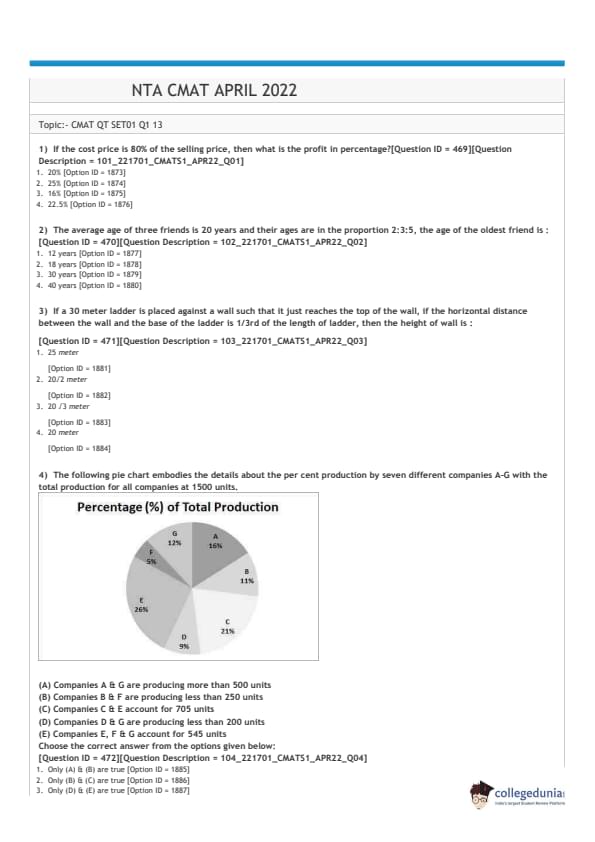
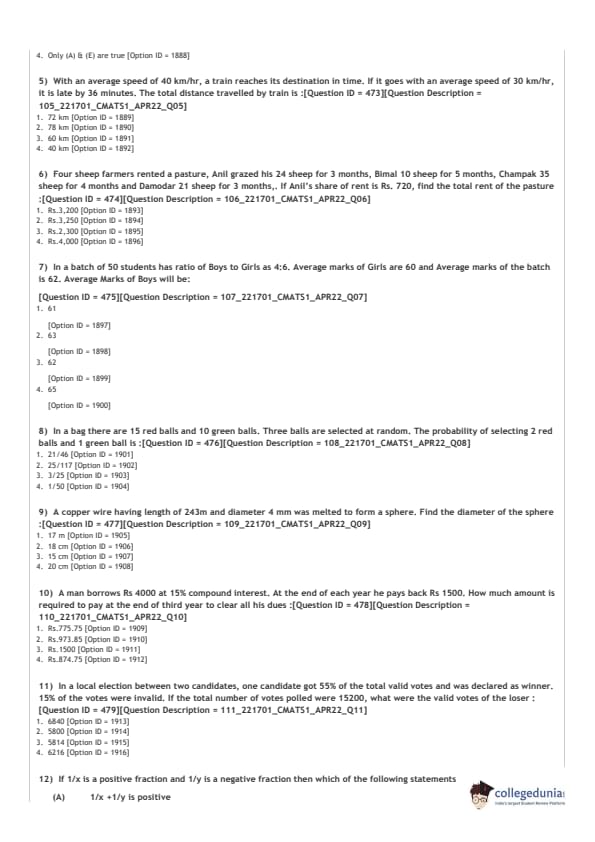

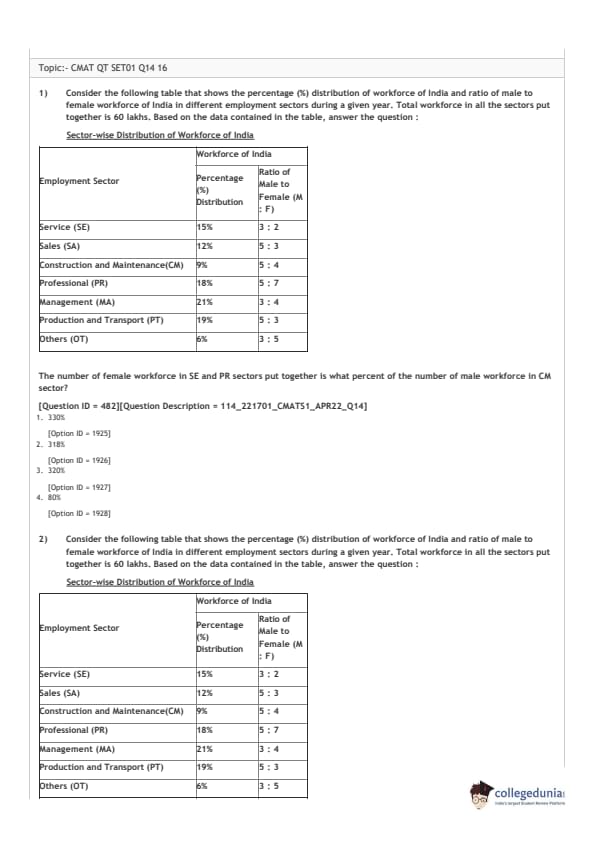
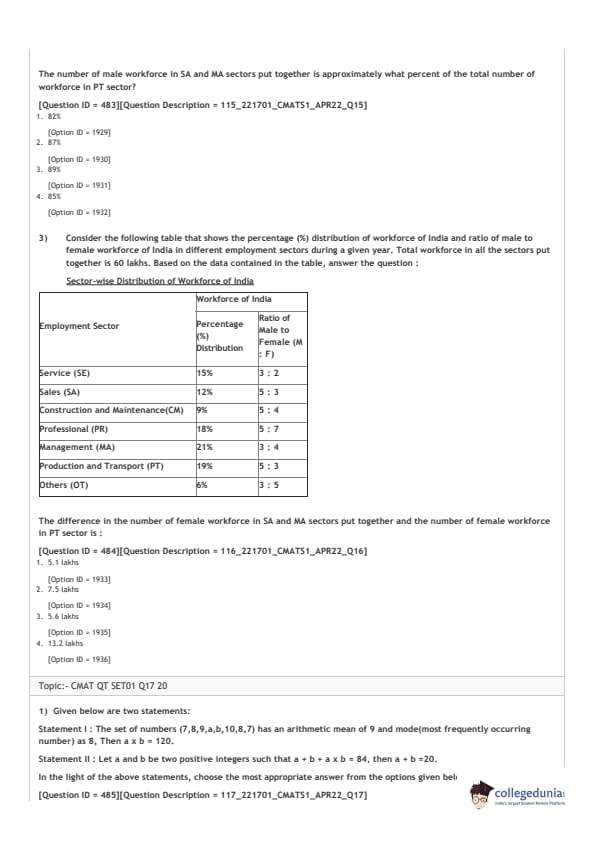
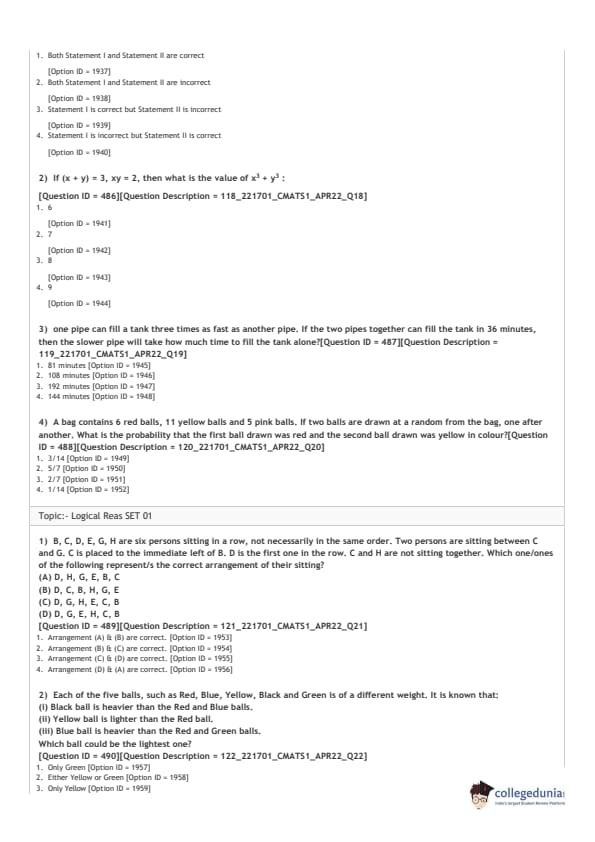

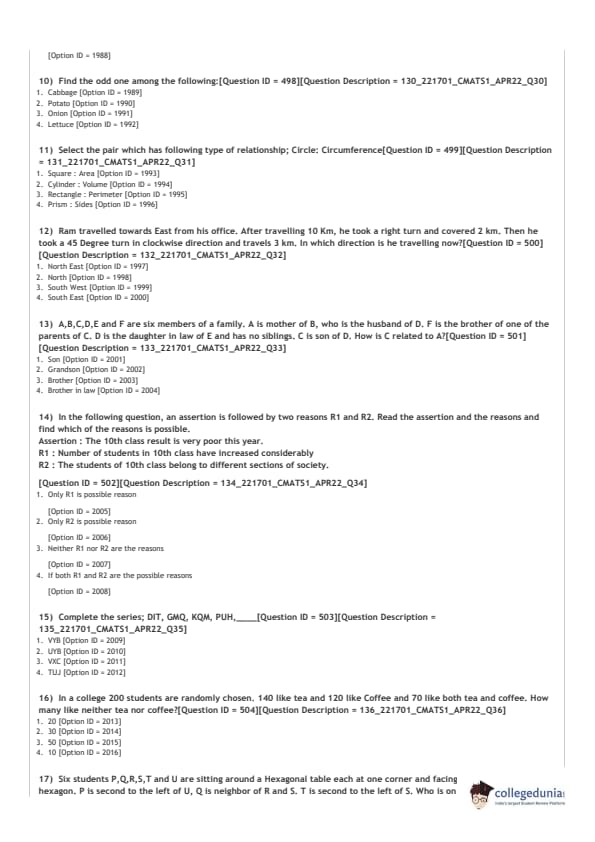
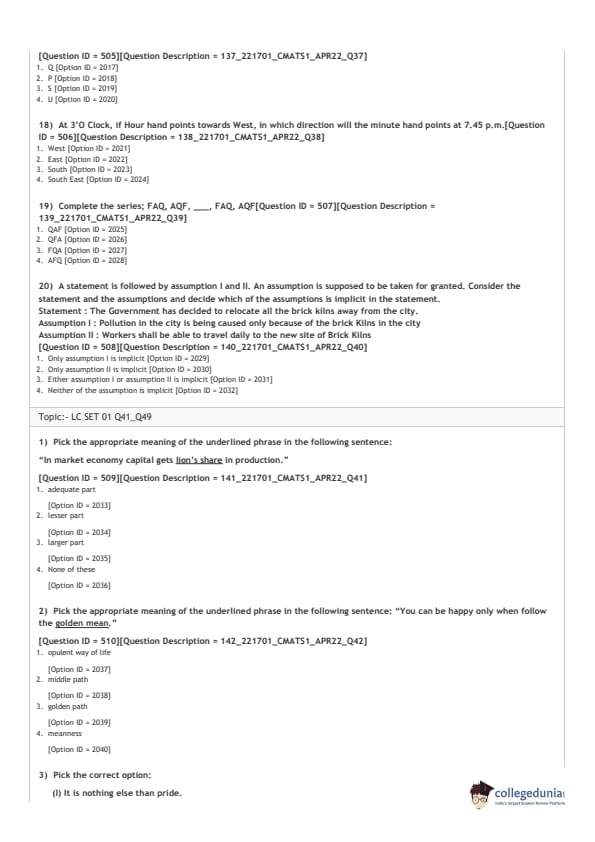




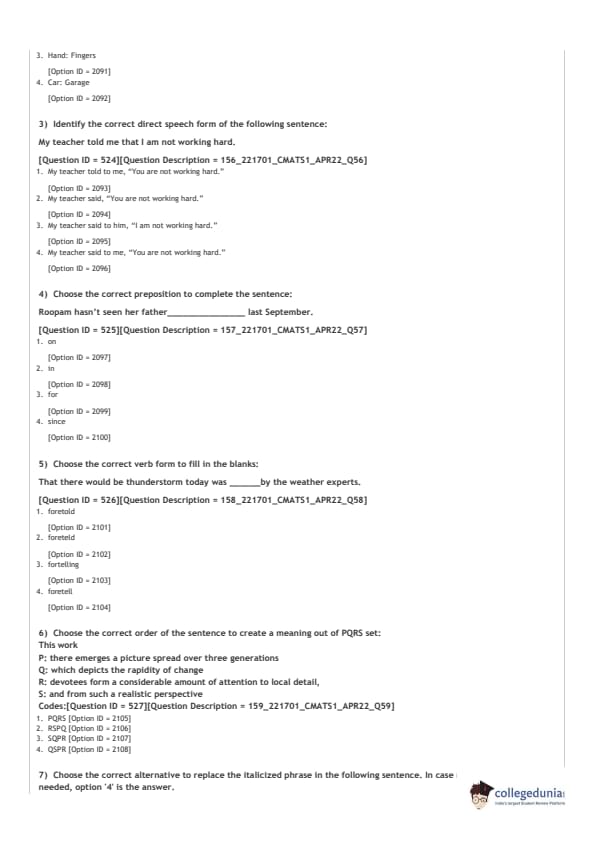
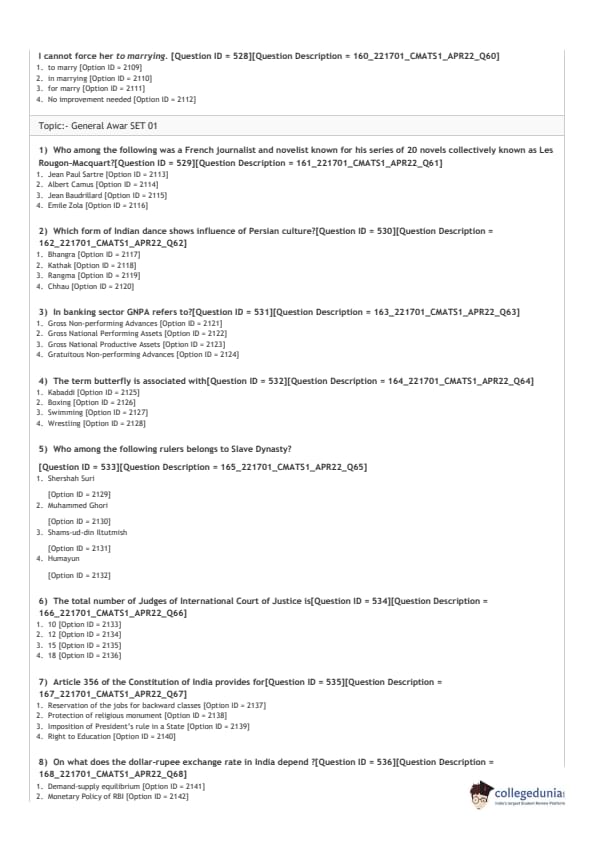
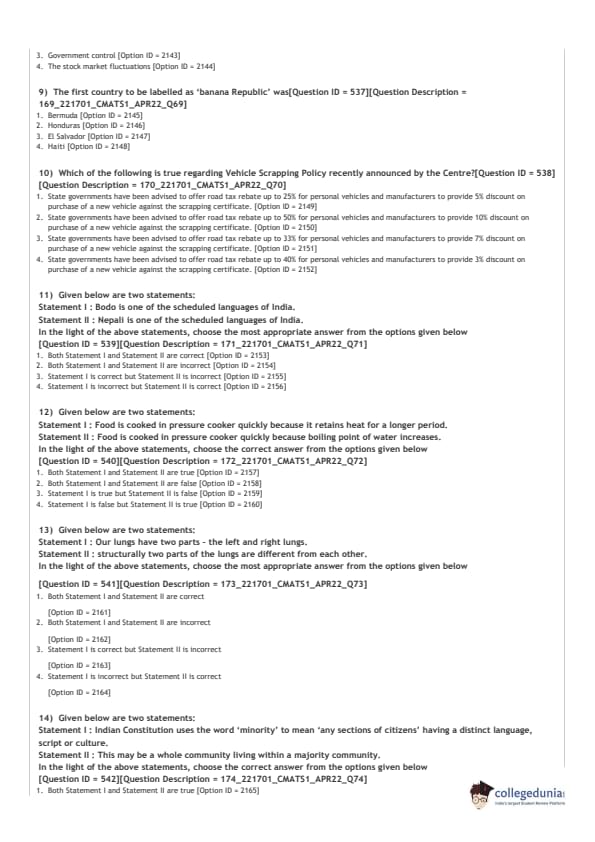
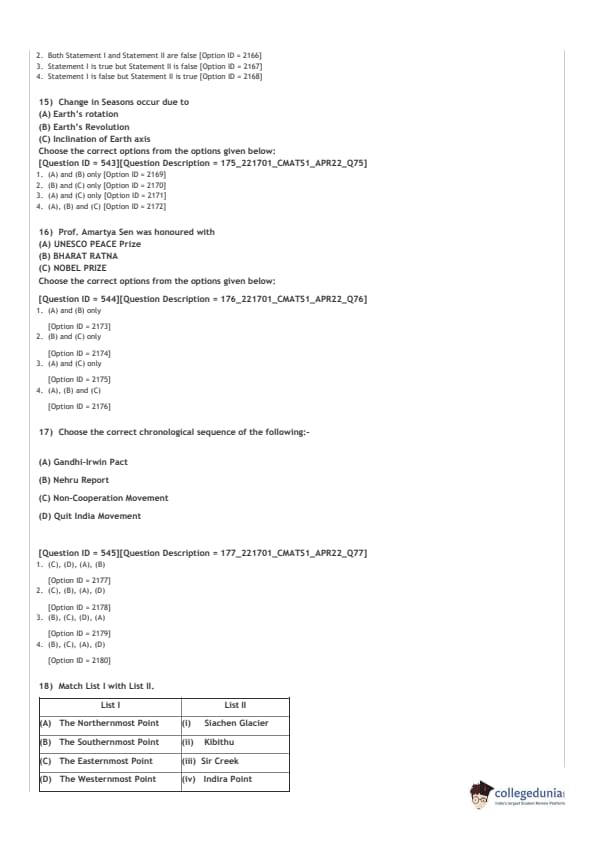

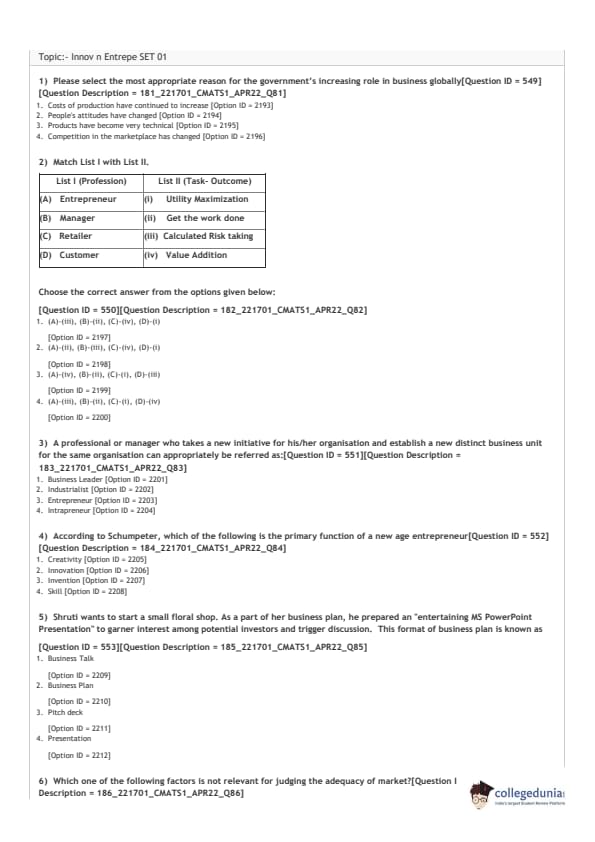
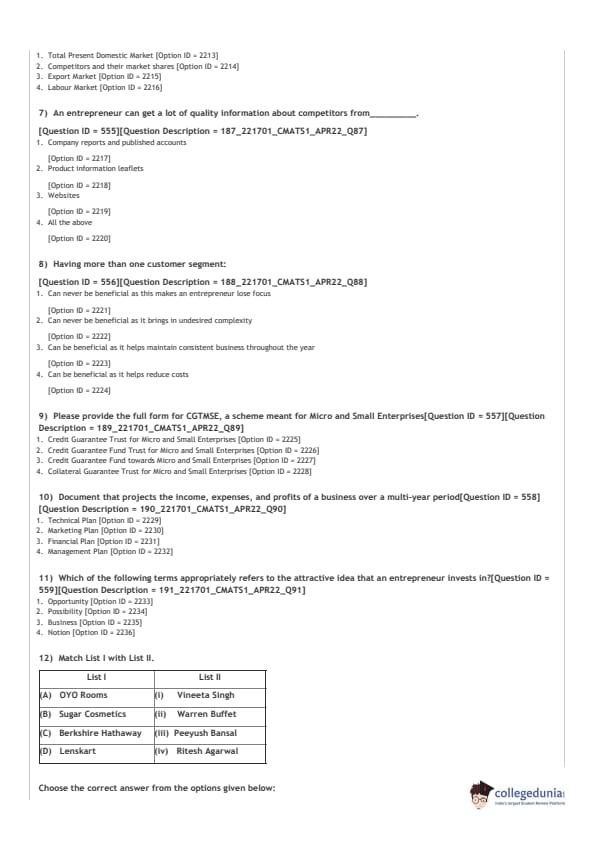
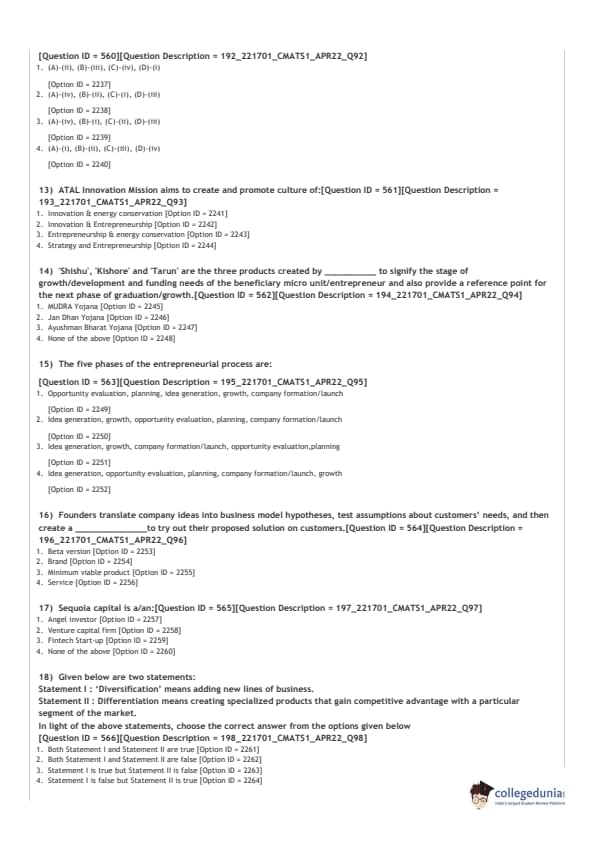

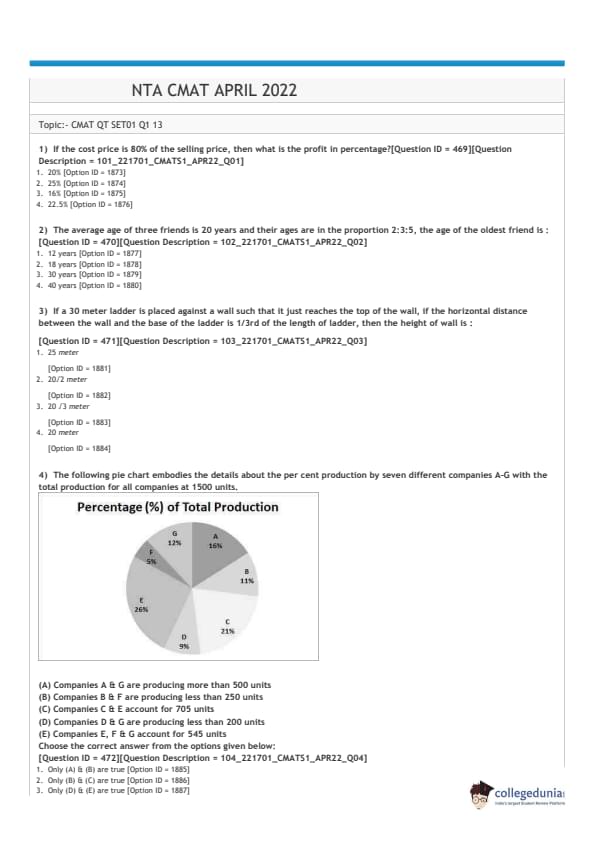
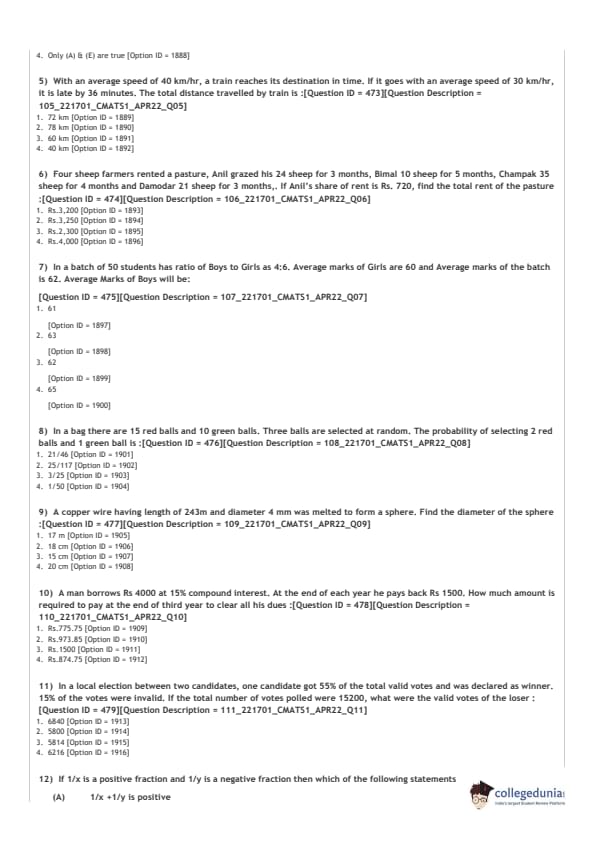
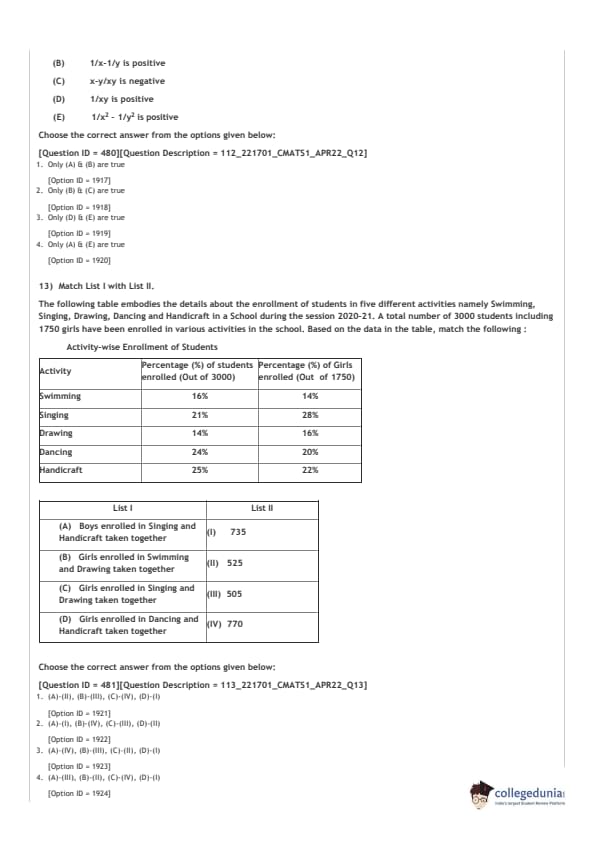



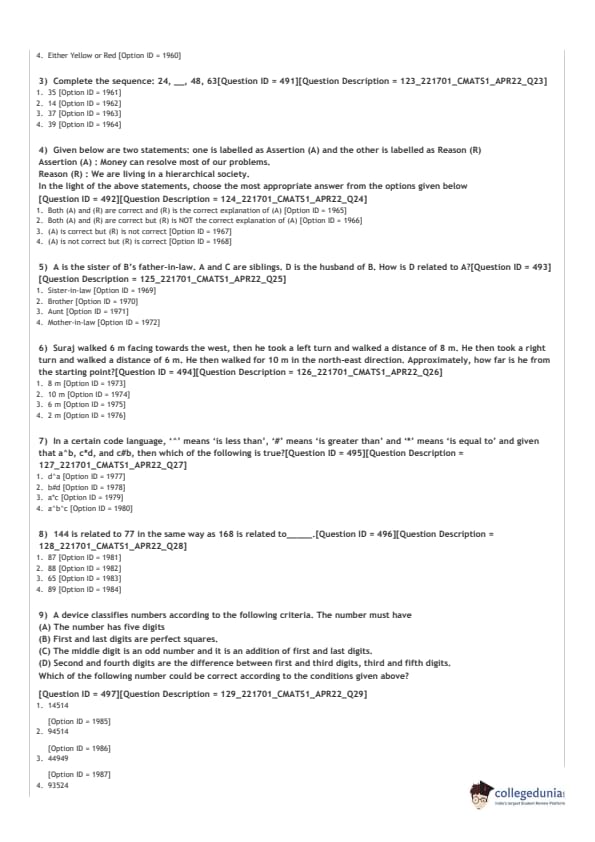

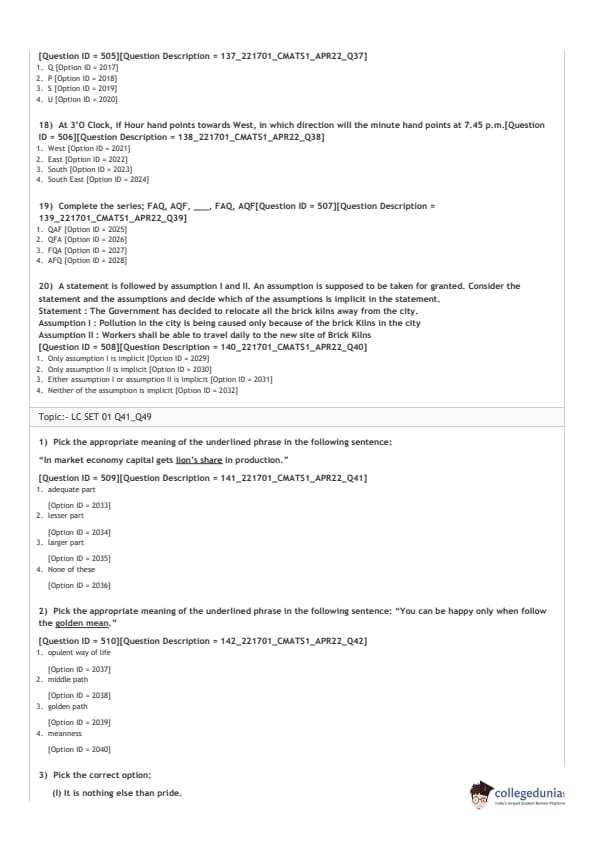


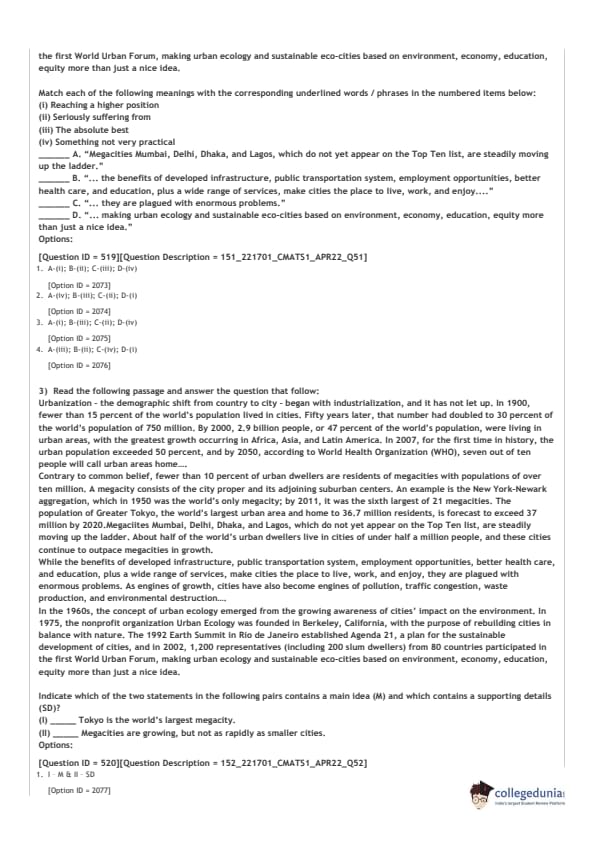
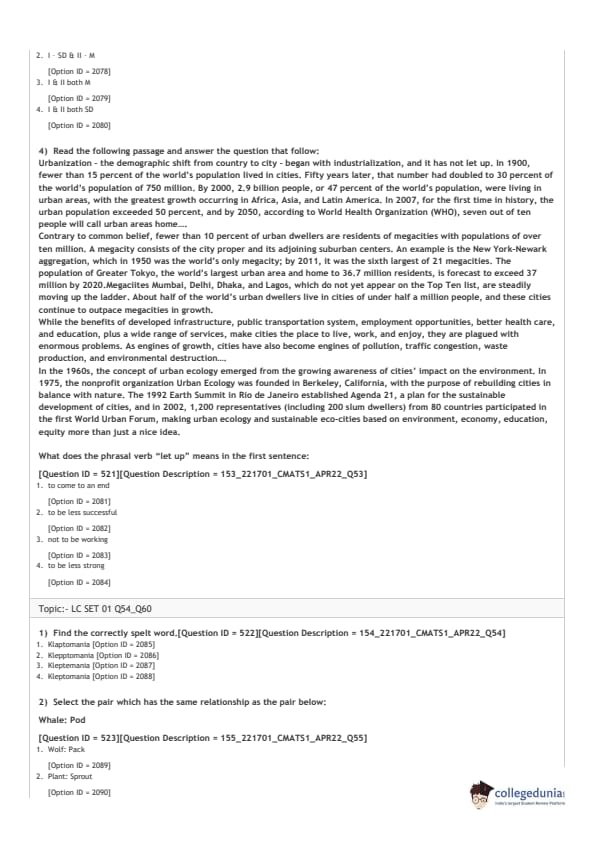
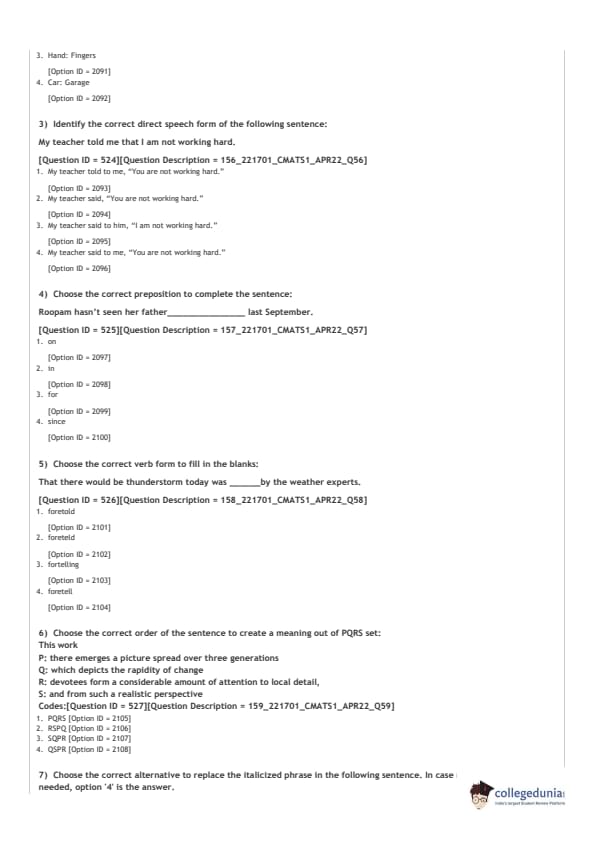
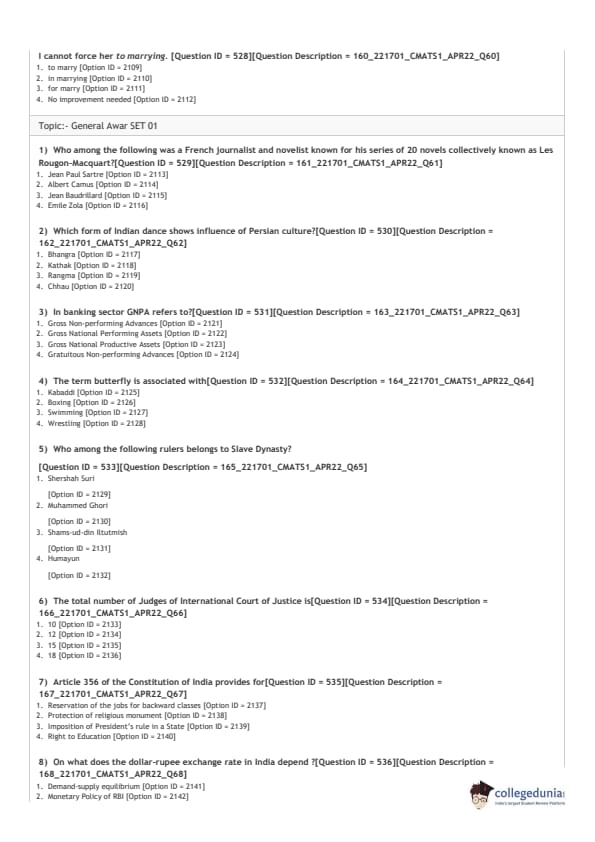
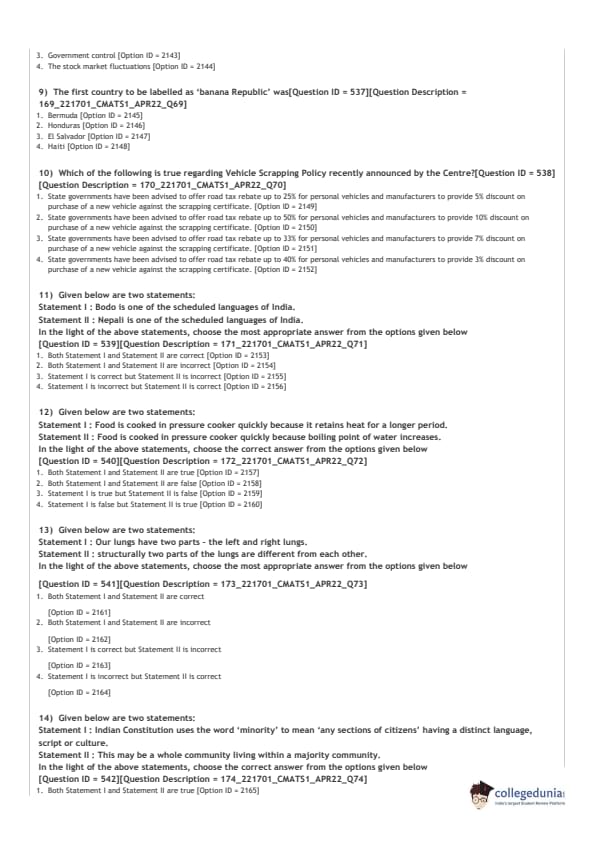
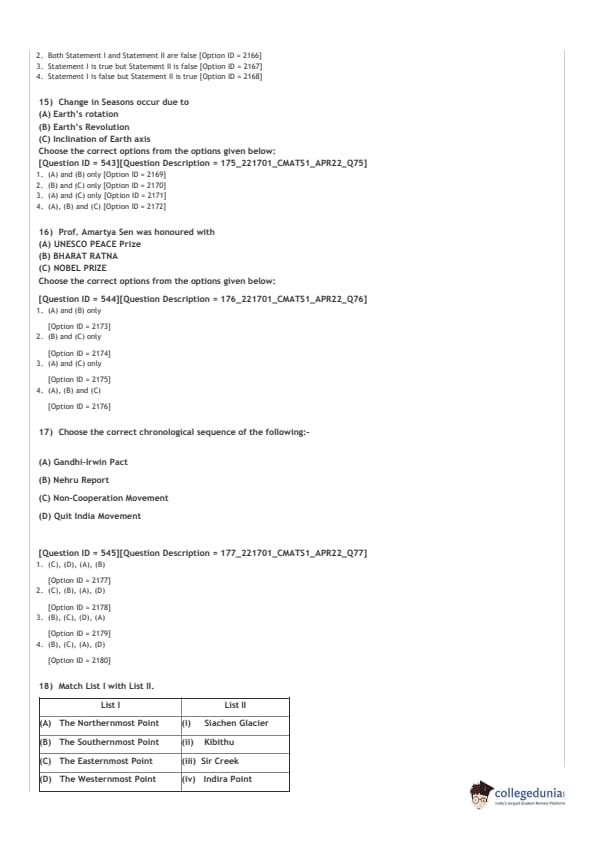
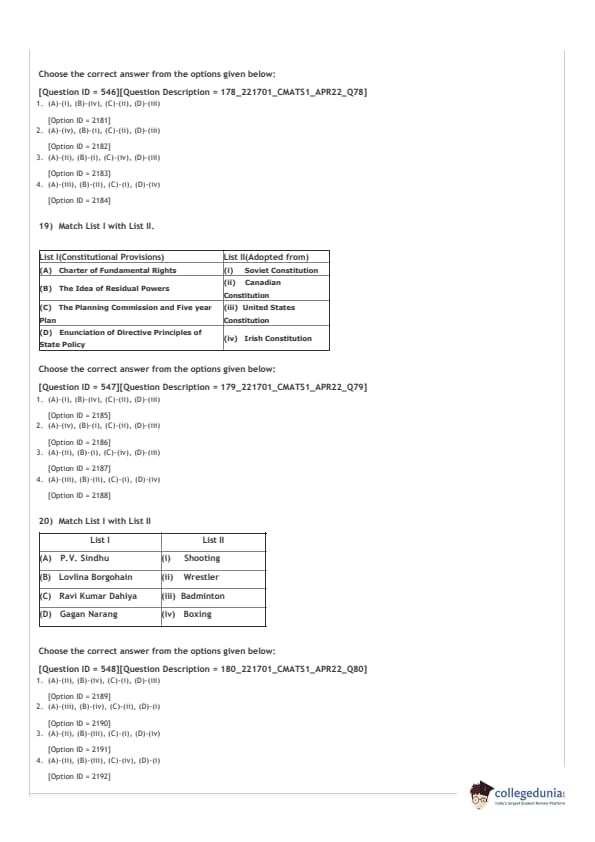
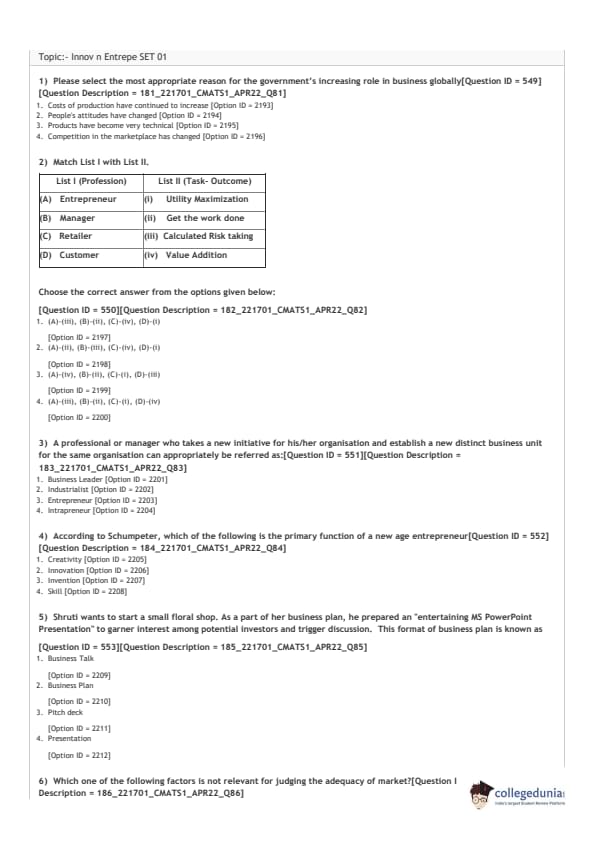

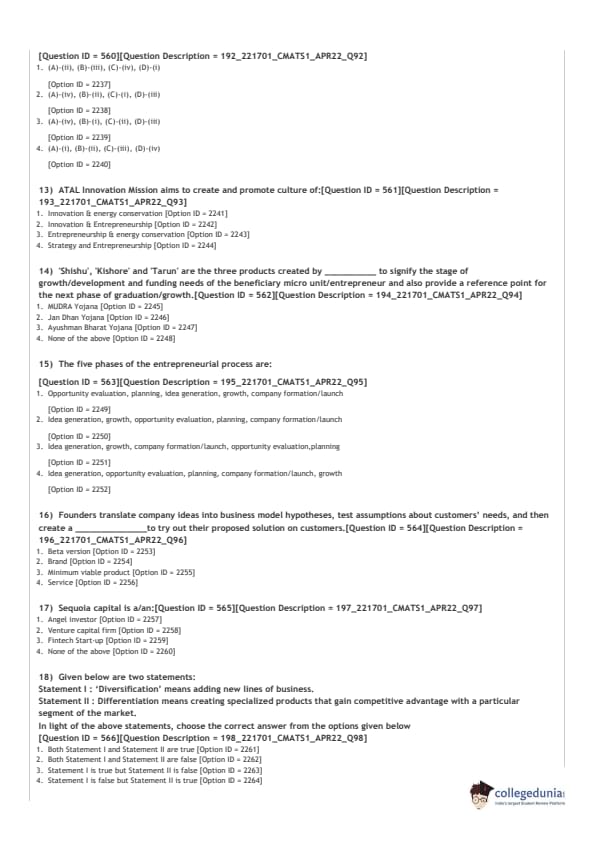


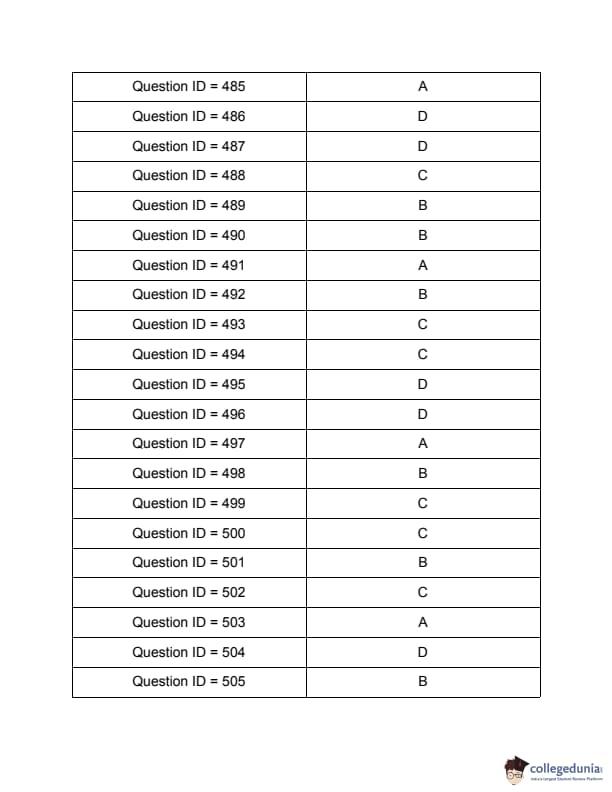
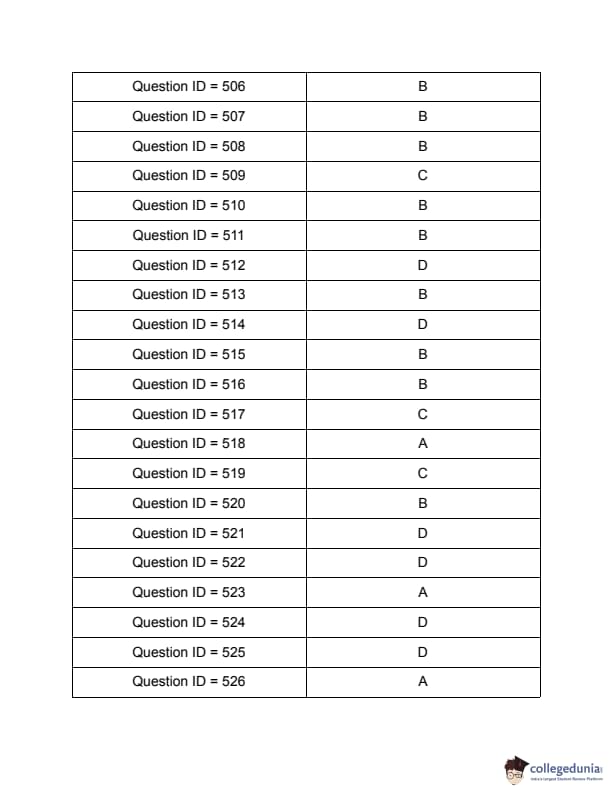
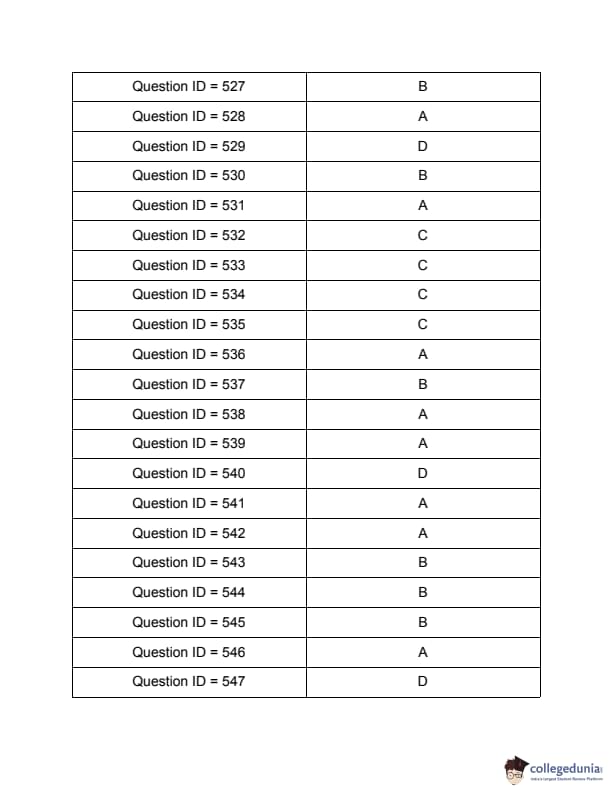

CMAT Previous Year Question Paper with Answer Key PDFs
| CMAT 2021 Question Papers | CMAT 2020 Question Papers | CMAT 2019 Question Papers |
| CMAT 2018 Question Papers | CMAT 2017 Question Papers | CMAT Practice Papers |



Comments